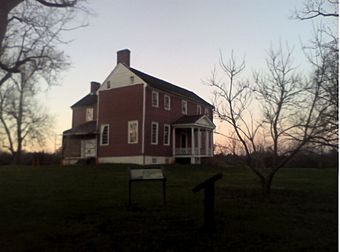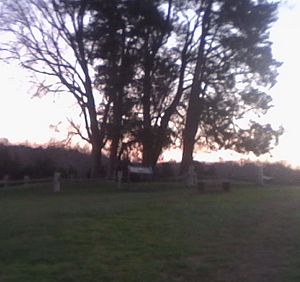Ellwood Manor facts for kids
Quick facts for kids |
|
|
Ellwood Manor
|
|
|
U.S. Historic district
Contributing property |
|
 |
|
| Lua error in Module:Location_map at line 420: attempt to index field 'wikibase' (a nil value). | |
| Nearest city | Fredericksburg, Virginia |
|---|---|
| Area | 4,601.1 acres (1,862.0 ha) |
| Built | 1790 |
| Built by | William Jones |
| Architectural style | Georgian |
| Part of | Fredericksburg and Spotsylvania County Battlefields Memorial National Military Park (ID66000046) |
Ellwood Manor is a beautiful Georgian-style house built around 1790 by William Jones. It was once located in Spotsylvania County, Virginia but is now in Orange County, Virginia. For over 100 years, Ellwood was the center of a large farm, known as a plantation, near the Chancellorsville crossroads. This area was on the main road between Fredericksburg and Orange, Virginia, which is now Virginia State Route 3.
Just before the American Civil War, a man named J. Horace Lacy married William Jones' younger daughter. After some legal discussions, he became the owner of both Ellwood and another large property called Chatham Manor. During the Civil War, both Lacy brothers became officers for the Confederate side. Caretakers looked after Ellwood when the armies weren't using it for battles.
Confederate soldiers used Ellwood as a headquarters and then as a hospital after the Battle of Chancellorsville in 1863. A chaplain named Beverly Tucker Lacy even buried General Stonewall Jackson's arm in the family cemetery at Ellwood. The general's arm had been amputated after he was accidentally shot by his own troops. The next year, before the Battle of the Wilderness, Union General Gouverneur K. Warren used Ellwood as his headquarters. Later, it became a Union hospital. After the war, Ellwood went back to being a farm. Today, the house is the only building left from the Battle of the Wilderness. It was given to the government in 1977 and is now part of the Fredericksburg and Spotsylvania National Military Park.
Contents
Ellwood's Early Days
Long ago, the land where Ellwood Manor stands was given to Governor Alexander Spottswood. He didn't build on it, but the county was named after him. During the American Revolutionary War, Churchill Jones was a Major. After the war, he joined his brother William Jones, who had started a farm in an area called the Wilderness. Around 1790, William Jones began building the house he named Ellwood.
In 1781, soldiers led by the Marquis de Lafayette stayed at Ellwood. They were waiting for more troops before heading to the final battle of the war at Yorktown. Churchill Jones built another house nearby. It is said that "Light-Horse Harry" Lee wrote his war memories at Ellwood. In 1825, the Marquis de Lafayette visited Ellwood again during a special trip back to the United States.
William Jones had a large family. After his first wife passed away, he married Lucinda Gordon. They had a daughter named Betty. When William Jones died in 1845, he left Ellwood to Lucinda. She later gave Ellwood to their daughter, Betty, who married J. Horace Lacy.
Life on the Plantation
In 1860, J. Horace Lacy owned many enslaved people, about 249, and a lot of land. Most of the enslaved people worked on the fields or in the house at Ellwood. Some were also skilled workers like millers, carpenters, and blacksmiths. Today, historians are still looking for where the enslaved people's homes used to be on the property.
Ellwood During the Civil War
Before the Civil War, the Lacy brothers, J. Horace Lacy and Beverly Tucker Lacy, owned Ellwood. J. Horace Lacy joined the Confederate Army. His brother, Beverly Tucker Lacy, was a minister and became a chaplain for General Stonewall Jackson. General Jackson's arm was buried at Ellwood after it was amputated.
The Lacy brothers left Ellwood in the care of two caretakers. These caretakers supported the Confederate side. Because of this, they were arrested in 1863 and held in Washington, D.C.
Ellwood's location was important during the war. It was used as a Confederate headquarters for a short time. Later, Union generals Gouverneur K. Warren and Ambrose Burnside used it as their headquarters. Ellwood also became a major Union hospital during the battles fought to control the road to the Confederate capital.
After the War
When the Civil War ended in 1865, Ellwood was badly damaged and mostly empty for eight years. Many graves of soldiers were on the property. Later, groups came to move the soldiers' remains from the site. In 1872, the Lacys sold Chatham Manor to pay taxes, but they kept Ellwood. They lived there for the next 35 years.
Betty Lacy helped start the Ladies Memorial Association of Fredericksburg. This group created the Confederate Cemetery. Her husband traveled and gave speeches to raise money. In 1903, a monument was put up to mark where Stonewall Jackson's arm was buried. For a long time, this was the only marked grave in the family cemetery.
Ellwood Today
After Betty Lacy passed away in 1907, a law professor named Hugh Evander Willis bought Ellwood. His family owned it until 1971, when they gave it to the National Park Service. The Park Service officially accepted the donation in 1977.
Today, Ellwood Manor and its surrounding land are open to the public. You can visit during certain hours.
Since 1998, a group called the Friends of Wilderness Battlefield has helped take care of Ellwood. They work to preserve the historic building and its grounds. New exhibits were added in 2010. The house is open from 10 a.m. to 5 p.m. on summer weekends and holidays, and from May through October.
See also
- Battle of Chancellorsville
- Historic houses in Virginia



